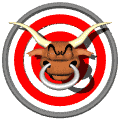
Raymonds Important Stuff !

Life can be ruff sometimes, even for a little doggie !

So can I get ATTENTION, please !?!
K-9 FIRST AID
By Adela Morris & Shay Cook
This
information is only a guide for giving first aid to a dog.
It is not intended to replace veterinary care, but to
give FIRST AID until you can get professional help.
____________________
This paper is for Search and Rescue dog handlers who are trained to, at least, the Advanced First Aid and CPR level. We would like to share ideas with you about taking responsibility for your canine partner's health. Learn how to read your dog for signs of a medical problem and how to make decisions about when to get more advanced medical help if needed.
SKELETON OF DOG

NORMAL VALUES FOR YOUR DOG
|
Capillary refill time |
less than 1 second |
|
Mucous membrane color |
generally pink |
|
Temperature |
101 to 102 degrees F |
|
Pulse rate at rest |
young dogs
110 - 120 bpm |
|
Respiratory rate |
young 20 -
25 |
|
Hydration |
pick up skin and release, it should return within 1 second |
Capillary refill time is measured by pressing on the gums over the canine tooth. Using one finger, press down firmly until the gums turn white under your finger and release. You are looking for the time it took for the color to return. Also, note the color of your dogs gums and mouth. Dogs gum color can vary from black, pink, reddish brown or any combination of colors.
Temperature is taken rectally with an adult rectal thermometer. You should hold it in place for 1 to 2 minutes. If you get a temperature of less than 100 degrees F, re-take the temperature to make sure the thermometer was in place long enough.
The pulse rate and respiration rate will vary from dog to dog, and will also vary if the dog is at rest or working. So, it is a good idea to get normal values for both.
RECOGNIZING SIGNS OF SHOCK
Shock is a condition resulting from a depressed state of many vital body functions, caused by a lack of effective circulation. It is a life threatening condition that is reversible if treated in time. Some causes of shock are; severe loss of blood, burns, trauma, snake bites, poison, lack of oxygen, or prolonged vomiting with diarrhea.
Symptoms of shock include:
Pale color in gums / inside eyelids, capillary refill time greater than 2 seconds.
Dry lips and gums, dehydration.
Excessive drooling in some poison cases.
Weak femoral pulse, rapid 150 to 200 beats per minute.
Rapid heart rate.
Cool Extremities.
Hyperventilation, rapid breathing generally over 25 breaths per minute.
Confusion, restless, anxiousness.
General weakness.
Advanced stages of shock:
Continued depression and weakness to the point of not being able to move or becoming unresponsive or unconscious.
Dilated pupils.
Capillary refill time greater than 4 seconds.
White mucous membranes.
Body temperature below 98 degrees F, taken rectally.
Treatment
ABC's
Insure adequate ventilation.
Control any bleeding.
Keep dog quiet and calm to prevent further injury.
Keep body temperature normal.
Get dog to veterinarian so fluid replacement and medication can be
started.
An injured dog or an animal in shock may not recognize you. Your own dog may bite you out of pain or fear. It is very important to talk to the dog in very soft and reassuring tones. If the dog is having trouble breathing or panting heavily do not put a muzzle on it. If a muzzle is placed on the dog it must be monitored at all times and removed at the first sign of overheating or vomiting. Get help, if possible from someone who can help hold the dog, so you can do an examination and/or treat the dog.
WOUNDS AND BLEEDING
Abrasions
Usually minor.
Some bleeding.
Always a possibility of infection.
Treatment
Carefully
remove foreign objects and debris.
May have to cut or clip hair away from area.
Clean wound liberally with water and chlorhexidine or Betadine scrubs
or solutions if available. If not, any soap will be beneficial.
Solution does not have to be rinsed, scrub must be rinsed copiously. (Avoid
using hydrogen peroxide. It can damage tissue.)
Major lacerations and bleeding
Can be life threatening.
May need to be sutured by a vet.
Treatment
|
Control bleeding. |
1.
Additional direct pressure |
|
Get professional help right away. Also see the above treatment for laceration |
|
Bandaging principles
Protect wound from further injury or infection.
Discourage licking.
Restrict movement.
Secure splint.
Prevent weight bearing.
Provide compression to control bleeding and edema.
Verify
circulation is maintained to toes, make sure to cushion pads.
FRACTURES AND SUSPECTED FRACTURES
Signs and Symptoms
Obvious pain
Loss of use of the limb
Protruding bone
Swelling
Irregularity or deformity
Limping
Treatment
Remember,
shock and bleeding should be controlled first.
Treat dislocation as fracture.
Do not push bone back through skin.
Cover an open fracture with clean dressing.
Limb fracture below elbow or knee apply a Robert Jones bandage from
toes to shoulder or hip.
Unfortunately, there is no agreed upon or standard for first aid for a
fracture of the humerus or femur.
Transport to appropriate facilities ASAP.
Splinting principles
Immobilization of fracture or suspected fracture. (This requires immobilization of both the joint above and the joint below the fracture.)
Decrease pain.
Prevent shock.
Prevent further injury to surrounding tissue.
Provide compression to control bleeding and edema.
EMERGENCY AND TRAUMA
SNAKE BITES
Signs/Symptoms
Pain
Lethargy
Vomiting
Diarrhea
Salivation, thirsty
Swelling at the area of the bite
Shock
Treatment
Seek immediate veterinary care. While transporting, immobilize the part of the animal that has been bitten, keeping below the heart level. A constricting band may be used, with caution, to impede the spread of the venom. Keep the animal calm and confined during the transport. If you can identify the snake species, it may be helpful in treatment.
STINGS
Signs/Symptoms
Pain
Swelling and redness
Pawing at face
Snapping in the air
Treatment
If you see the stinger, get it out. Cool compression will help alleviate the sting. Give oral benedryl (diphenhydramine 2-4mg/kg orally every 8 hours). Seek medical attention if swelling persists/gets worse or if the sting is near the head/neck/throat area.
HEAT EXHAUSTION
Signs/Symptoms
Fatigue
Circulatory collapse
Red mucous membrane (gums)
Excessive panting
Dehydration
Shaking
Treatment
Seek shade, rest the dog, offer small amounts of water. Seek veterinary care if condition does not improve.
HEAT STROKE
Signs/Symptoms
Excessive panting
Rectal temperature above 105-106 degrees F
Disorientation
Weakness
Rapid pulse/breathing
Brick red mucous membranes
Treatment
Get the dog into shade, into a creek if available. Use same precautions as with human, don't use ice water bath. Slowly cool down the body temperature, immerse in a cool water bath. Ice can be placed, with caution, under armpits, head, neck, and groin area, being sure to wrap in cloth first. Monitor temperature, avoiding cooling too much. Transport to veterinary hospital.
BLOAT
Bloat is the common terminology for Gastric Dilatation/Torsion. This is most common in larger - deep chested dogs. Gastric dilatation is the enlargement of the stomach beyond its normal dimensions. Gastric dilatation volvulus is when the stomach actually rotates on itself. This is a life threatening situation.
Signs/Symptoms
Dry retching/unproductive vomit
Restlessness
Anxiousness
Distended abdomen (hardened)
Drooling excessively
Depression
Shock
Treatment
Take to
the veterinary hospital immediately.
To monitor the bloat you can take a measuring tape (webbing or leash
could work) and measure the distance around the dog, just caudal (past)
the last rib. Monitor and make sure it is not enlarging, mark it with
a pen to keep accurate.
Prevention
Feed your dog his/her ration of food in, at least, two feedings a day (am/pm). Avoid giving lots of water at once, offer water more frequently. Avoid exercise approximately 1-2 hours before and after feeding.
POISON
Signs/Symptoms
Breathing difficulty
Unusual actions
Digestive upset
Irregular heart, rapid, or weak
Shivering
Convulsions
Salivation
There are many different types of poisoning, each will affect your dog
differently. Many do not produce immediate symptoms. Find out what
your local poison control number is and call them. Keep 1-800-548-2423
with you. Do not make the dog vomit if it is a caustic poison or you
do not know what kind of poison the dog has consumed. Consult poison
control or a veterinarian for further instructions.
Types of poisons and a brief reaction description are:
Anti
Coagulant Rodenticides
Warfarin
These rodenticides will cause the dog's blood to stop clotting in
hours or a day. This does not show immediate signs like other poisons.
Make your dog vomit, further veterinary care is necessary for survival.
Seek immediate veterinary care bringing the box of poison with
you.
Other
Rodenticides
ANTU
Thallium
Pindone
Strychnine
Sodium Floro-acetate (1080)
Zinc Phosphide
May cause fatal pulmonary edema, seizures, liver or kidney destruction,
or severe hemorrhagic gastroenteritis. If the dog is conscious, induce
vomiting, give Toxiban, collect the product label, and transport to
the veterinarian.
Pesticides
Arsenic
Chlorinated Hydrocarbons
Organophosphates
Carbonates
Rotenone
Metaldehyde
The signs are more immediate for most
of these. General profuse salivation, stomach pain and cramps, labored
breathing, bluish mucous membranes, seizures/convulsions, rigidity,
extended legs and many other signs. IMMEDIATELY SEEK VETERINARY CARE.
Glycol's
Antifreeze
Signs may not be readily apparent. The dog may actually appear a bit "drunken".
The fatal effect of ethylene glycol occurs hours later and is
irreversible at that point. Immediately rinse the dogs mouth, feet and
any other points of contact. Induce vomiting if conscious and give
Toxiban. Transport immediately to veterinarian.
Miscellaneous poisons
Acid
Alkalies
Garbage
Toxic plants
Chocolate
Acid - Clean off what you can see, do not induce vomiting, transport
to vet.
Alkalies - Clean off what you can see, do not induce vomiting,
transport to vet.
Garbage - Remove what you can, induce vomiting, give activated
charcoal....do not give lomotil.
Toxic plants - Take a sample of the suspected plant to a local
veterinarian.
Chocolate - If more than 1 oz/kg of baking chocolate is consumed, or 2
oz/kg of semi-sweet chocolate, or 4 oz/kg of Milk chocolate, induce
vomiting, give activated charcoal and transport to vet. (note, the fat
content of some milk chocolate products can cause life threatening
pancreatitis).
CPR AND RESCUE BREATHING
Airways
The first priority is to establish an unobstructed airway. Open airways by extending head and neck. Check and remove any foreign materials from the mouth and pull the tongue forward.
Breathing
Look and listen for signs of breathing. If none, place your hands around the muzzle to prevent air from escaping and breathe forcefully into the nostrils. The chest should expand and fall if you are getting air into the lungs. Do not be too forceful with small animals. Rescue breathing should be given at a rate of 8 to 10 breaths per minute (or one breath every 6 seconds).

Cardiopulmonary resuscitation (CPR)
If there is no pulse, place the dog on a hard surface with its right side down. Use the heel of your hand to compress the chest on the lower side immediately behind the elbow. The compression should be firm and not a sudden blow. It helps to have 2 people; the first gives the cardiac massage, the second does the breathing. CPR should be given at a rate of 80 to 120 compressions per minute with two ventilations being given every 15 compressions of the chest.

Drugs & Electrical Manipulation
Drugs and electrical manipulation can only be done by a veterinarian. For the best chance to save your dog, get to a veterinarian as quickly as possible! Even if you revive your dog by doing rescue breathing or CPR, take your dog to a vet for a complete exam.
FIELD FIRST AID KIT
This is a list of equipment and supplies that you will want to carry in your field first aid kit. The * indicates things that you will need to obtain from a veterinarian. It's a good idea to talk to your veterinarian and let him know the kind of work you do with your dog. Remember you want to keep your field pack as small and light as possible. Carry only the things that you will need for an emergency. Your car or flight pack is a good place to carry bulky first aid supplies like extra tape, bandages, and roll cotton.
tweezer
hemostat / forceps
scissors / emergency shears
thermometer
safety pins
3" x 3" gauze sponges
Ace elastic bandage
triangular bandage
Band-Aids
2" roll gauze / Conform stretch bandage
Sam splint
1" adhesive tape
exam gloves
non-adhering dressing / Telfa / Release
2" roll Medi-Rip / Vetwrap
Betadine solution
Sting ease
Aspirin
K-Y jelly
Benadryl (2-4mg/kg)
*
Antibiotics (Ampicillin / Tetracycline)
* Topical ointments (Panalog / Tritop / Neomycin / Neosporin)
* Ophthalmic Ointment without steroid (Mycitracin / Terramycin)
* Steroid (Prednisolone)
* Anti-diarrhea medication
* Emetic, to cause the dog to vomit (Apomorphine)
The items in parentheses are only a suggestion. Your Veterinarian may have you use other drugs or products.
EMERGENCY PRE-PLAN FOR WORKING SEARCH DOGS
Meet With Your Veterinarian
Talk to your veterinarian to see if he/she would be available to assist in an emergency after hours or on weekends. It's important to let them know the type of work you do with your dog. In the event of an emergency it might be hours or even a day before you can get your dog to professional help.
Discuss with your veterinarian how they would like you to handle emergencies such as: hyperthermia, allergic reactions, snake bites, lacerations, fractures, diarrhea/vomiting and poisoning before you get your dog to them or the closest vet. Go over the first aid kit and medication ideas. Are they willing to provide you with some basic drugs and instructions on how to use them in an emergency? The list of medications is only a suggestion, each veterinarian will have medications they prefer to use. Don't make a First Aid kit with things you don't know how to use or what they are for.
If your dog has been injured or treated for an emergency in the field it is important to call your vet and update him upon your return. Your vet may recommend a follow up exam and further treatments or just appreciate being updated.
Field First Aid Kit
This kit will always be taken with you when you go out in the field. A field first aid kit is a small to minimum sized kit and only contains things to treat emergencies in the field. The medications and supplies don't last forever. Make sure all medications have expiration dates on them. Keep tape in a plastic bag to avoid its drying out. The most important thing to remember is that when you use up supplies in your first aid kit you replace them ASAP.
Car First Aid Kit
Make a larger kit to keep in your car that contains more supplies like dressings, bulky bandaging supplies, splints, stethoscope, sterile water etc.
Medical Records and Vaccination Certificates
Ask your veterinarian for a copy of your dogs records and certificates for vaccinations. They are very important to have if your dog is being treated for any condition or has any medical problems. You should carry a copy of your dogs current vaccinations.
K-9 EXAM PRACTICE
Because normal values vary from dog to dog, this will be a reference of what is normal for your dog. Please print and complete and put in your First Aid Kit for reference.
GLOSSARY OF COMMON ABBREVIATIONS AND TERMS USED IN VETERINARY MEDICINE
|
BP |
blood pressure |
BID |
twice daily |
|
CRT |
capillary refill time |
DX |
diagnosis |
|
EOD |
every other day |
FX |
fracture |
|
HBC |
hit by car |
IM |
intramuscular |
|
IV |
intravenous |
LRS |
lactated ringers solution |
|
NSF |
no significant findings |
PCV |
packed cell volume |
|
PRN |
as necessary |
QD |
once daily |
|
QOD |
every other day |
RBC |
red blood cell |
|
RX |
prescription |
SID |
temperature, pulse, respiration |
|
TX |
treatment |
WBC |
white blood cell |
Alopecia
- hair loss
Ataxia - lack of coordination
Capillary - tiny blood vessels connecting arteries with veins
Distal - away from the center
Dorsal - back, posterior
Dyspnea - difficult or labored breathing
Edema - large amounts of fluid in subcutaneous tissues
Emesis - vomit
Gastroenteritis - inflammation of the stomach and intestine
Hematoma - a blood filled swelling
Hydration - to combine with water
Hyperventilation - rapid or deep breathing that over oxygenates
the blood causing dizziness
Jaundice - yellowing of the skin
Lateral - side away from the center
Luxation - dislocation
Otic - relating to the ear
Pancreat - pertaining to the pancreas
Pneumo - pertaining to the lungs
Polydipsia - excess thirst
Polyuria - passage of greater than normal amounts of urine
Proximal - nearer or towards center
Renal - relating to the kidneys
Thoracic - Pertaining to the chest cavity
Ventilation - circulate air to oxygenate blood
Ventral - sternum or belly side
Zoonosis - disease of animals that can be transmitted to humans

ALWAYS treat your best friend with RESPECT !!!

Are you listening to me !?!

We can suffer too, you know !?!

Donīt just look the other way !


We lay our lives in your hands !
Please VOTE for us IF YOU LIKE our WEBSITE friends !!!
It ONLY takes a MINUTE !
Just CLICK on RAYMOND ABOVE & then YES...thank you SO much, MOST appreciated !